Economics Report: Market Analysis of McDonald's Business in Australia
VerifiedAdded on 2023/06/04
|8
|2036
|274
Report
AI Summary
This report provides an in-depth analysis of McDonald's business operations within the Australian market. It begins with an introduction to McDonald's, highlighting its global presence and adaptability to local markets. The report then delves into the market structure, classifying it as an oligopoly with key competitors like KFC and Subway. It examines the influence of competitors on pricing decisions, noting the impact of price leadership and product differentiation. The analysis further explores the overall fast-food industry in Australia, emphasizing the changing consumer preferences towards healthier options. The report discusses how changes in market conditions, such as increased competition, affect McDonald's profitability. Finally, it concludes by summarizing McDonald's dominant position in the Australian market, its strategic responses to market dynamics, and its prospects for continued success. The report uses various sources to support its findings, including market share data, revenue figures, and academic research on the fast-food industry.
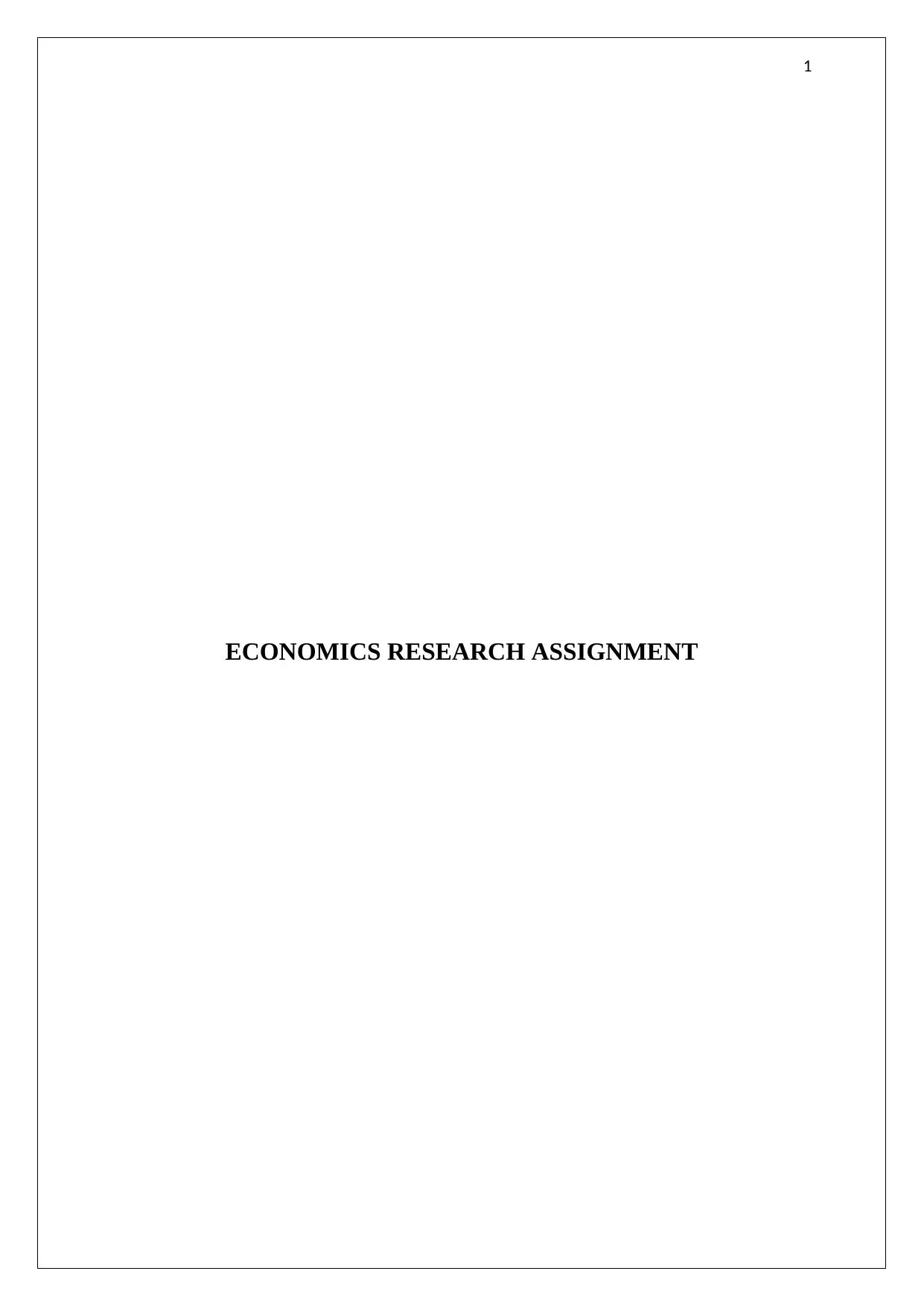
1
ECONOMICS RESEARCH ASSIGNMENT
ECONOMICS RESEARCH ASSIGNMENT
Paraphrase This Document
Need a fresh take? Get an instant paraphrase of this document with our AI Paraphraser
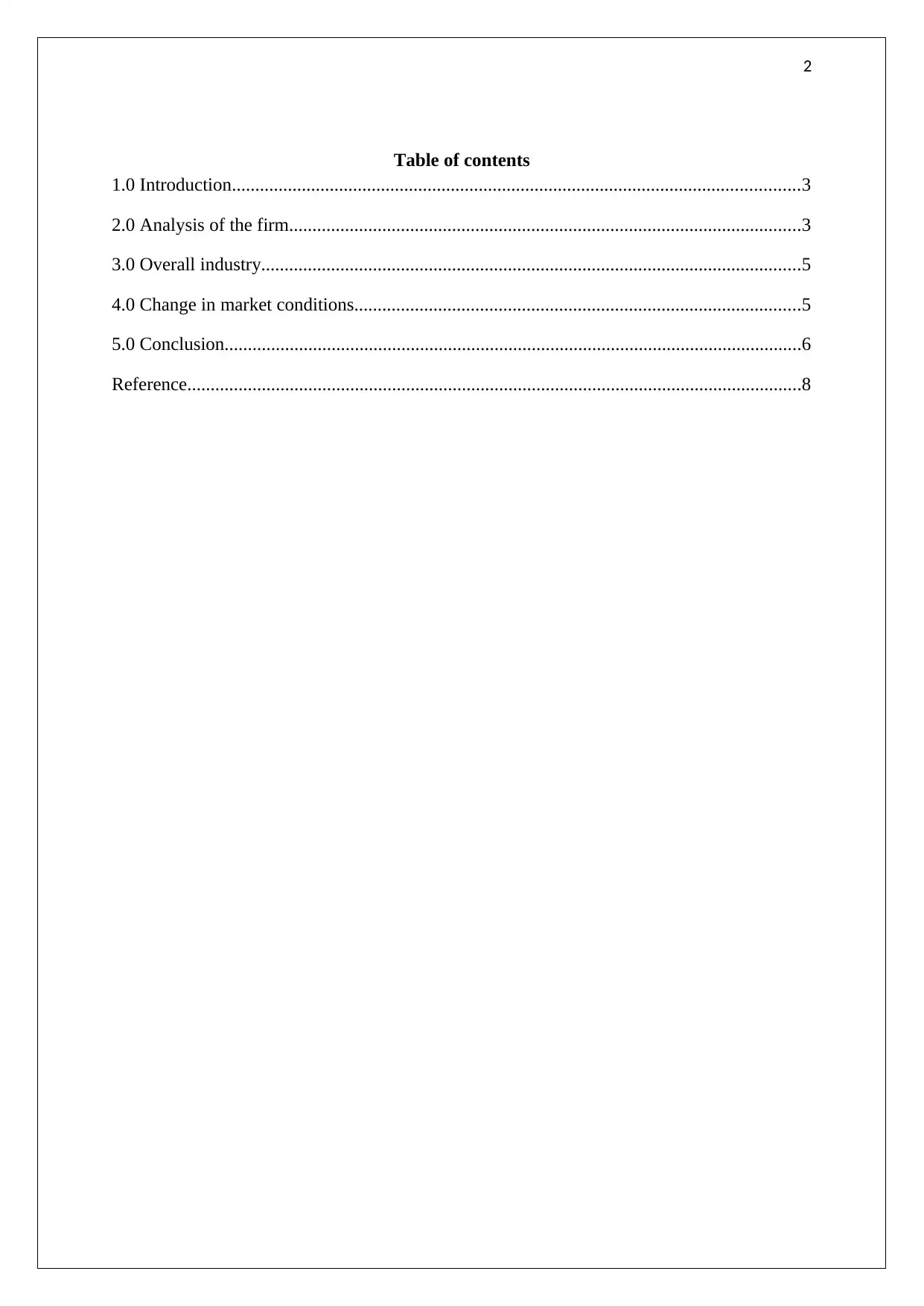
2
Table of contents
1.0 Introduction..........................................................................................................................3
2.0 Analysis of the firm..............................................................................................................3
3.0 Overall industry....................................................................................................................5
4.0 Change in market conditions................................................................................................5
5.0 Conclusion............................................................................................................................6
Reference....................................................................................................................................8
Table of contents
1.0 Introduction..........................................................................................................................3
2.0 Analysis of the firm..............................................................................................................3
3.0 Overall industry....................................................................................................................5
4.0 Change in market conditions................................................................................................5
5.0 Conclusion............................................................................................................................6
Reference....................................................................................................................................8
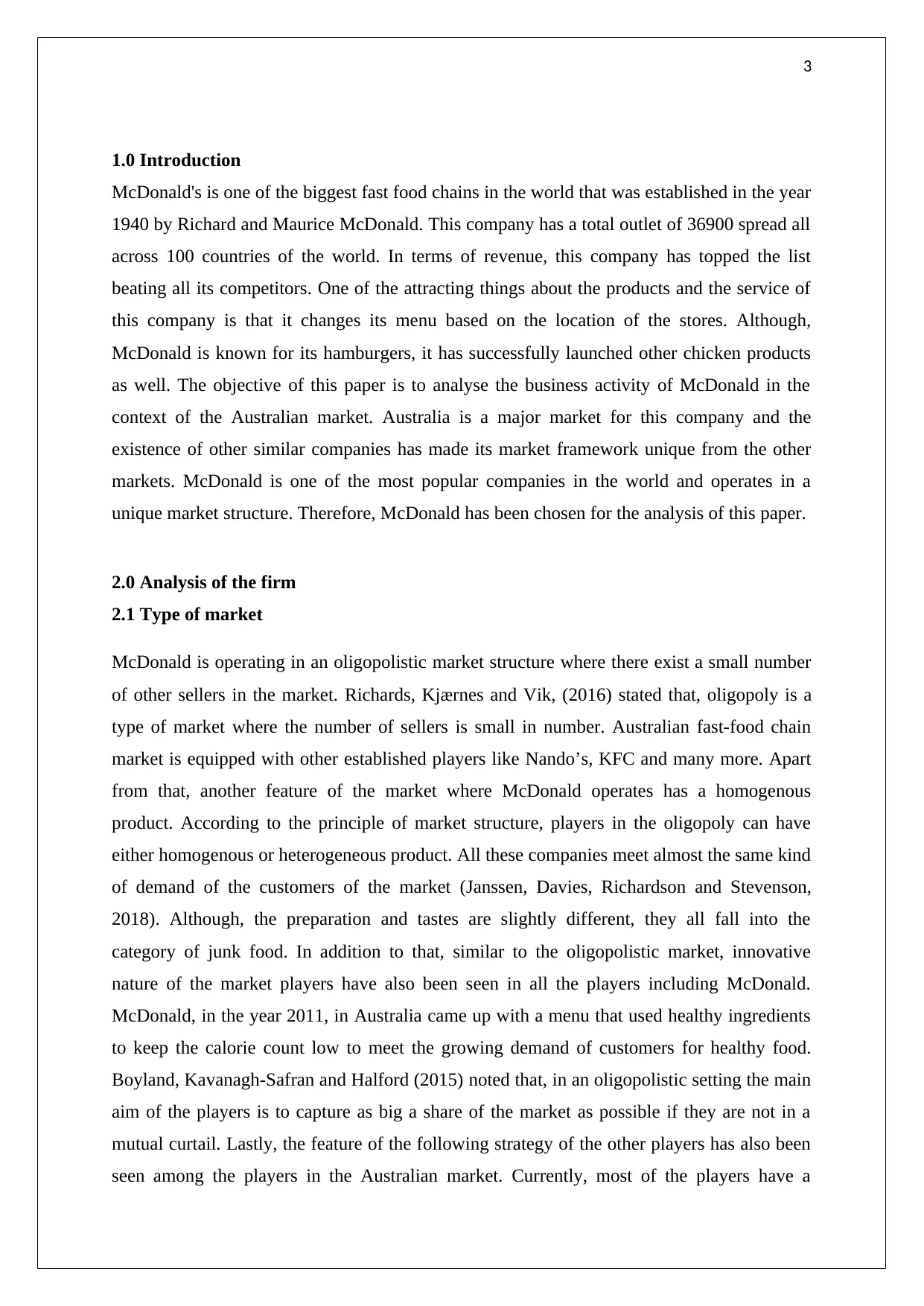
3
1.0 Introduction
McDonald's is one of the biggest fast food chains in the world that was established in the year
1940 by Richard and Maurice McDonald. This company has a total outlet of 36900 spread all
across 100 countries of the world. In terms of revenue, this company has topped the list
beating all its competitors. One of the attracting things about the products and the service of
this company is that it changes its menu based on the location of the stores. Although,
McDonald is known for its hamburgers, it has successfully launched other chicken products
as well. The objective of this paper is to analyse the business activity of McDonald in the
context of the Australian market. Australia is a major market for this company and the
existence of other similar companies has made its market framework unique from the other
markets. McDonald is one of the most popular companies in the world and operates in a
unique market structure. Therefore, McDonald has been chosen for the analysis of this paper.
2.0 Analysis of the firm
2.1 Type of market
McDonald is operating in an oligopolistic market structure where there exist a small number
of other sellers in the market. Richards, Kjærnes and Vik, (2016) stated that, oligopoly is a
type of market where the number of sellers is small in number. Australian fast-food chain
market is equipped with other established players like Nando’s, KFC and many more. Apart
from that, another feature of the market where McDonald operates has a homogenous
product. According to the principle of market structure, players in the oligopoly can have
either homogenous or heterogeneous product. All these companies meet almost the same kind
of demand of the customers of the market (Janssen, Davies, Richardson and Stevenson,
2018). Although, the preparation and tastes are slightly different, they all fall into the
category of junk food. In addition to that, similar to the oligopolistic market, innovative
nature of the market players have also been seen in all the players including McDonald.
McDonald, in the year 2011, in Australia came up with a menu that used healthy ingredients
to keep the calorie count low to meet the growing demand of customers for healthy food.
Boyland, Kavanagh-Safran and Halford (2015) noted that, in an oligopolistic setting the main
aim of the players is to capture as big a share of the market as possible if they are not in a
mutual curtail. Lastly, the feature of the following strategy of the other players has also been
seen among the players in the Australian market. Currently, most of the players have a
1.0 Introduction
McDonald's is one of the biggest fast food chains in the world that was established in the year
1940 by Richard and Maurice McDonald. This company has a total outlet of 36900 spread all
across 100 countries of the world. In terms of revenue, this company has topped the list
beating all its competitors. One of the attracting things about the products and the service of
this company is that it changes its menu based on the location of the stores. Although,
McDonald is known for its hamburgers, it has successfully launched other chicken products
as well. The objective of this paper is to analyse the business activity of McDonald in the
context of the Australian market. Australia is a major market for this company and the
existence of other similar companies has made its market framework unique from the other
markets. McDonald is one of the most popular companies in the world and operates in a
unique market structure. Therefore, McDonald has been chosen for the analysis of this paper.
2.0 Analysis of the firm
2.1 Type of market
McDonald is operating in an oligopolistic market structure where there exist a small number
of other sellers in the market. Richards, Kjærnes and Vik, (2016) stated that, oligopoly is a
type of market where the number of sellers is small in number. Australian fast-food chain
market is equipped with other established players like Nando’s, KFC and many more. Apart
from that, another feature of the market where McDonald operates has a homogenous
product. According to the principle of market structure, players in the oligopoly can have
either homogenous or heterogeneous product. All these companies meet almost the same kind
of demand of the customers of the market (Janssen, Davies, Richardson and Stevenson,
2018). Although, the preparation and tastes are slightly different, they all fall into the
category of junk food. In addition to that, similar to the oligopolistic market, innovative
nature of the market players have also been seen in all the players including McDonald.
McDonald, in the year 2011, in Australia came up with a menu that used healthy ingredients
to keep the calorie count low to meet the growing demand of customers for healthy food.
Boyland, Kavanagh-Safran and Halford (2015) noted that, in an oligopolistic setting the main
aim of the players is to capture as big a share of the market as possible if they are not in a
mutual curtail. Lastly, the feature of the following strategy of the other players has also been
seen among the players in the Australian market. Currently, most of the players have a
⊘ This is a preview!⊘
Do you want full access?
Subscribe today to unlock all pages.

Trusted by 1+ million students worldwide
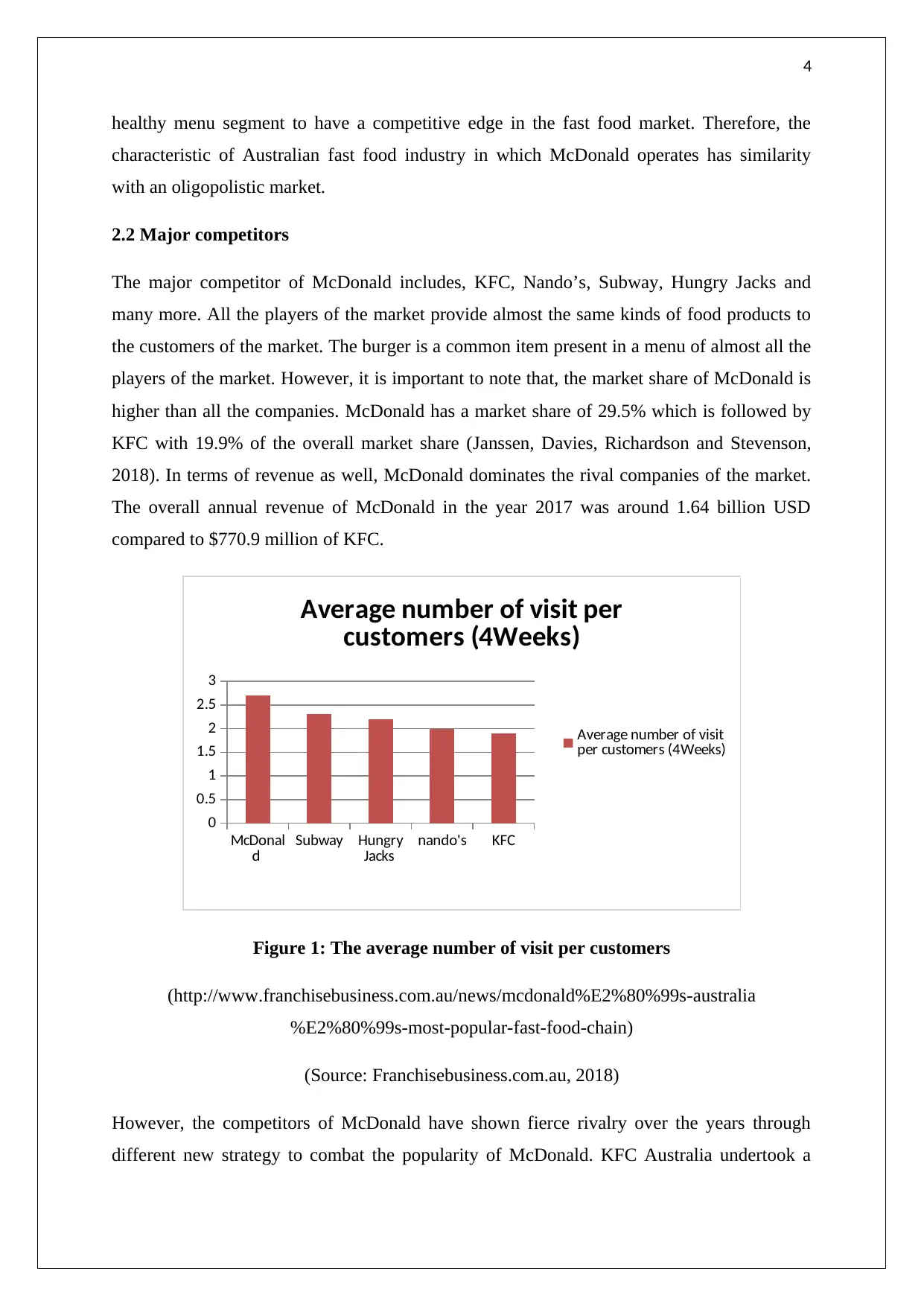
4
healthy menu segment to have a competitive edge in the fast food market. Therefore, the
characteristic of Australian fast food industry in which McDonald operates has similarity
with an oligopolistic market.
2.2 Major competitors
The major competitor of McDonald includes, KFC, Nando’s, Subway, Hungry Jacks and
many more. All the players of the market provide almost the same kinds of food products to
the customers of the market. The burger is a common item present in a menu of almost all the
players of the market. However, it is important to note that, the market share of McDonald is
higher than all the companies. McDonald has a market share of 29.5% which is followed by
KFC with 19.9% of the overall market share (Janssen, Davies, Richardson and Stevenson,
2018). In terms of revenue as well, McDonald dominates the rival companies of the market.
The overall annual revenue of McDonald in the year 2017 was around 1.64 billion USD
compared to $770.9 million of KFC.
McDonal
d Subway Hungry
Jacks nando's KFC
0
0.5
1
1.5
2
2.5
3
Average number of visit per
customers (4Weeks)
Average number of visit
per customers (4Weeks)
Figure 1: The average number of visit per customers
(http://www.franchisebusiness.com.au/news/mcdonald%E2%80%99s-australia
%E2%80%99s-most-popular-fast-food-chain)
(Source: Franchisebusiness.com.au, 2018)
However, the competitors of McDonald have shown fierce rivalry over the years through
different new strategy to combat the popularity of McDonald. KFC Australia undertook a
healthy menu segment to have a competitive edge in the fast food market. Therefore, the
characteristic of Australian fast food industry in which McDonald operates has similarity
with an oligopolistic market.
2.2 Major competitors
The major competitor of McDonald includes, KFC, Nando’s, Subway, Hungry Jacks and
many more. All the players of the market provide almost the same kinds of food products to
the customers of the market. The burger is a common item present in a menu of almost all the
players of the market. However, it is important to note that, the market share of McDonald is
higher than all the companies. McDonald has a market share of 29.5% which is followed by
KFC with 19.9% of the overall market share (Janssen, Davies, Richardson and Stevenson,
2018). In terms of revenue as well, McDonald dominates the rival companies of the market.
The overall annual revenue of McDonald in the year 2017 was around 1.64 billion USD
compared to $770.9 million of KFC.
McDonal
d Subway Hungry
Jacks nando's KFC
0
0.5
1
1.5
2
2.5
3
Average number of visit per
customers (4Weeks)
Average number of visit
per customers (4Weeks)
Figure 1: The average number of visit per customers
(http://www.franchisebusiness.com.au/news/mcdonald%E2%80%99s-australia
%E2%80%99s-most-popular-fast-food-chain)
(Source: Franchisebusiness.com.au, 2018)
However, the competitors of McDonald have shown fierce rivalry over the years through
different new strategy to combat the popularity of McDonald. KFC Australia undertook a
Paraphrase This Document
Need a fresh take? Get an instant paraphrase of this document with our AI Paraphraser
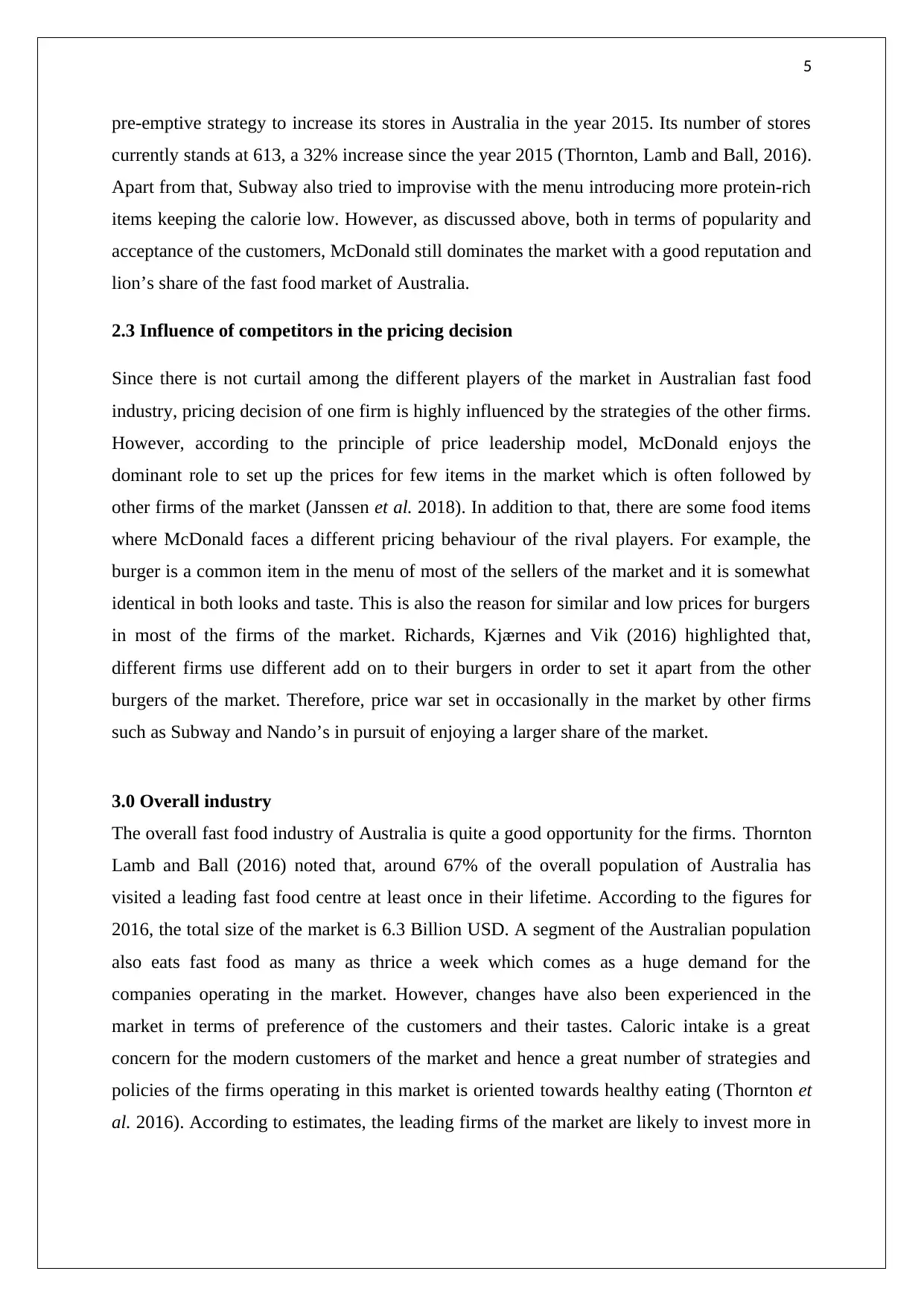
5
pre-emptive strategy to increase its stores in Australia in the year 2015. Its number of stores
currently stands at 613, a 32% increase since the year 2015 (Thornton, Lamb and Ball, 2016).
Apart from that, Subway also tried to improvise with the menu introducing more protein-rich
items keeping the calorie low. However, as discussed above, both in terms of popularity and
acceptance of the customers, McDonald still dominates the market with a good reputation and
lion’s share of the fast food market of Australia.
2.3 Influence of competitors in the pricing decision
Since there is not curtail among the different players of the market in Australian fast food
industry, pricing decision of one firm is highly influenced by the strategies of the other firms.
However, according to the principle of price leadership model, McDonald enjoys the
dominant role to set up the prices for few items in the market which is often followed by
other firms of the market (Janssen et al. 2018). In addition to that, there are some food items
where McDonald faces a different pricing behaviour of the rival players. For example, the
burger is a common item in the menu of most of the sellers of the market and it is somewhat
identical in both looks and taste. This is also the reason for similar and low prices for burgers
in most of the firms of the market. Richards, Kjærnes and Vik (2016) highlighted that,
different firms use different add on to their burgers in order to set it apart from the other
burgers of the market. Therefore, price war set in occasionally in the market by other firms
such as Subway and Nando’s in pursuit of enjoying a larger share of the market.
3.0 Overall industry
The overall fast food industry of Australia is quite a good opportunity for the firms. Thornton
Lamb and Ball (2016) noted that, around 67% of the overall population of Australia has
visited a leading fast food centre at least once in their lifetime. According to the figures for
2016, the total size of the market is 6.3 Billion USD. A segment of the Australian population
also eats fast food as many as thrice a week which comes as a huge demand for the
companies operating in the market. However, changes have also been experienced in the
market in terms of preference of the customers and their tastes. Caloric intake is a great
concern for the modern customers of the market and hence a great number of strategies and
policies of the firms operating in this market is oriented towards healthy eating (Thornton et
al. 2016). According to estimates, the leading firms of the market are likely to invest more in
pre-emptive strategy to increase its stores in Australia in the year 2015. Its number of stores
currently stands at 613, a 32% increase since the year 2015 (Thornton, Lamb and Ball, 2016).
Apart from that, Subway also tried to improvise with the menu introducing more protein-rich
items keeping the calorie low. However, as discussed above, both in terms of popularity and
acceptance of the customers, McDonald still dominates the market with a good reputation and
lion’s share of the fast food market of Australia.
2.3 Influence of competitors in the pricing decision
Since there is not curtail among the different players of the market in Australian fast food
industry, pricing decision of one firm is highly influenced by the strategies of the other firms.
However, according to the principle of price leadership model, McDonald enjoys the
dominant role to set up the prices for few items in the market which is often followed by
other firms of the market (Janssen et al. 2018). In addition to that, there are some food items
where McDonald faces a different pricing behaviour of the rival players. For example, the
burger is a common item in the menu of most of the sellers of the market and it is somewhat
identical in both looks and taste. This is also the reason for similar and low prices for burgers
in most of the firms of the market. Richards, Kjærnes and Vik (2016) highlighted that,
different firms use different add on to their burgers in order to set it apart from the other
burgers of the market. Therefore, price war set in occasionally in the market by other firms
such as Subway and Nando’s in pursuit of enjoying a larger share of the market.
3.0 Overall industry
The overall fast food industry of Australia is quite a good opportunity for the firms. Thornton
Lamb and Ball (2016) noted that, around 67% of the overall population of Australia has
visited a leading fast food centre at least once in their lifetime. According to the figures for
2016, the total size of the market is 6.3 Billion USD. A segment of the Australian population
also eats fast food as many as thrice a week which comes as a huge demand for the
companies operating in the market. However, changes have also been experienced in the
market in terms of preference of the customers and their tastes. Caloric intake is a great
concern for the modern customers of the market and hence a great number of strategies and
policies of the firms operating in this market is oriented towards healthy eating (Thornton et
al. 2016). According to estimates, the leading firms of the market are likely to invest more in
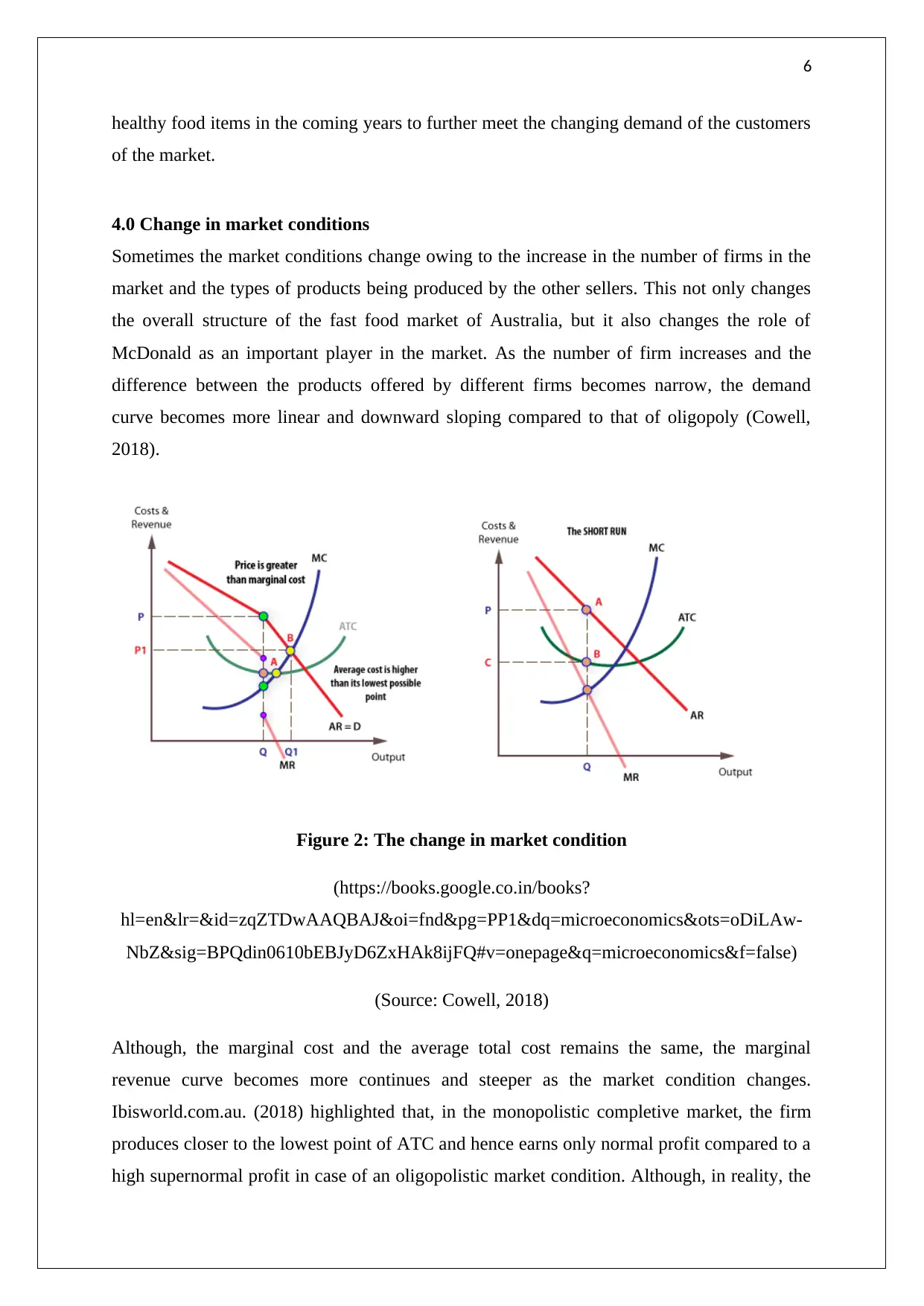
6
healthy food items in the coming years to further meet the changing demand of the customers
of the market.
4.0 Change in market conditions
Sometimes the market conditions change owing to the increase in the number of firms in the
market and the types of products being produced by the other sellers. This not only changes
the overall structure of the fast food market of Australia, but it also changes the role of
McDonald as an important player in the market. As the number of firm increases and the
difference between the products offered by different firms becomes narrow, the demand
curve becomes more linear and downward sloping compared to that of oligopoly (Cowell,
2018).
Figure 2: The change in market condition
(https://books.google.co.in/books?
hl=en&lr=&id=zqZTDwAAQBAJ&oi=fnd&pg=PP1&dq=microeconomics&ots=oDiLAw-
NbZ&sig=BPQdin0610bEBJyD6ZxHAk8ijFQ#v=onepage&q=microeconomics&f=false)
(Source: Cowell, 2018)
Although, the marginal cost and the average total cost remains the same, the marginal
revenue curve becomes more continues and steeper as the market condition changes.
Ibisworld.com.au. (2018) highlighted that, in the monopolistic completive market, the firm
produces closer to the lowest point of ATC and hence earns only normal profit compared to a
high supernormal profit in case of an oligopolistic market condition. Although, in reality, the
healthy food items in the coming years to further meet the changing demand of the customers
of the market.
4.0 Change in market conditions
Sometimes the market conditions change owing to the increase in the number of firms in the
market and the types of products being produced by the other sellers. This not only changes
the overall structure of the fast food market of Australia, but it also changes the role of
McDonald as an important player in the market. As the number of firm increases and the
difference between the products offered by different firms becomes narrow, the demand
curve becomes more linear and downward sloping compared to that of oligopoly (Cowell,
2018).
Figure 2: The change in market condition
(https://books.google.co.in/books?
hl=en&lr=&id=zqZTDwAAQBAJ&oi=fnd&pg=PP1&dq=microeconomics&ots=oDiLAw-
NbZ&sig=BPQdin0610bEBJyD6ZxHAk8ijFQ#v=onepage&q=microeconomics&f=false)
(Source: Cowell, 2018)
Although, the marginal cost and the average total cost remains the same, the marginal
revenue curve becomes more continues and steeper as the market condition changes.
Ibisworld.com.au. (2018) highlighted that, in the monopolistic completive market, the firm
produces closer to the lowest point of ATC and hence earns only normal profit compared to a
high supernormal profit in case of an oligopolistic market condition. Although, in reality, the
⊘ This is a preview!⊘
Do you want full access?
Subscribe today to unlock all pages.

Trusted by 1+ million students worldwide
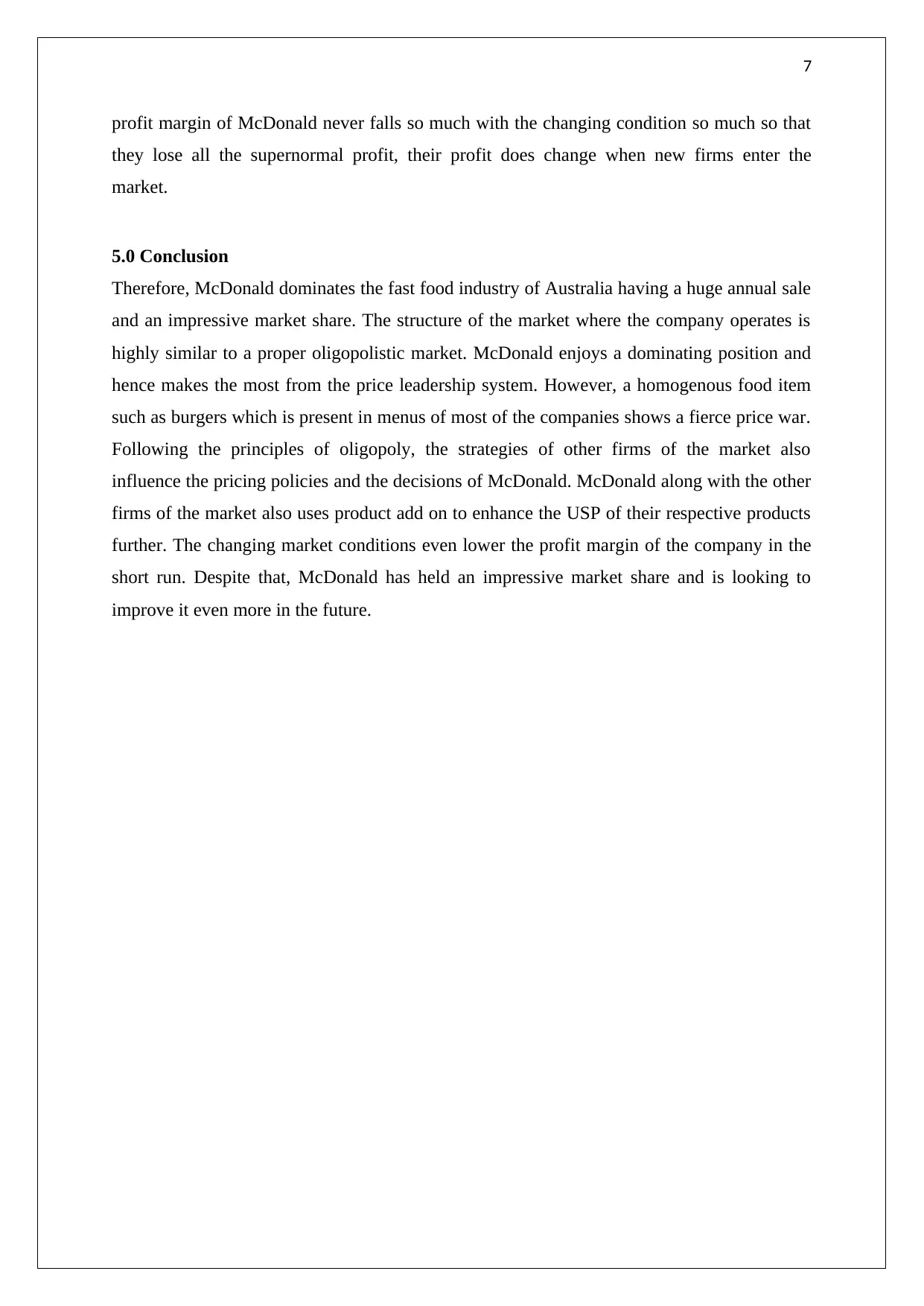
7
profit margin of McDonald never falls so much with the changing condition so much so that
they lose all the supernormal profit, their profit does change when new firms enter the
market.
5.0 Conclusion
Therefore, McDonald dominates the fast food industry of Australia having a huge annual sale
and an impressive market share. The structure of the market where the company operates is
highly similar to a proper oligopolistic market. McDonald enjoys a dominating position and
hence makes the most from the price leadership system. However, a homogenous food item
such as burgers which is present in menus of most of the companies shows a fierce price war.
Following the principles of oligopoly, the strategies of other firms of the market also
influence the pricing policies and the decisions of McDonald. McDonald along with the other
firms of the market also uses product add on to enhance the USP of their respective products
further. The changing market conditions even lower the profit margin of the company in the
short run. Despite that, McDonald has held an impressive market share and is looking to
improve it even more in the future.
profit margin of McDonald never falls so much with the changing condition so much so that
they lose all the supernormal profit, their profit does change when new firms enter the
market.
5.0 Conclusion
Therefore, McDonald dominates the fast food industry of Australia having a huge annual sale
and an impressive market share. The structure of the market where the company operates is
highly similar to a proper oligopolistic market. McDonald enjoys a dominating position and
hence makes the most from the price leadership system. However, a homogenous food item
such as burgers which is present in menus of most of the companies shows a fierce price war.
Following the principles of oligopoly, the strategies of other firms of the market also
influence the pricing policies and the decisions of McDonald. McDonald along with the other
firms of the market also uses product add on to enhance the USP of their respective products
further. The changing market conditions even lower the profit margin of the company in the
short run. Despite that, McDonald has held an impressive market share and is looking to
improve it even more in the future.
Paraphrase This Document
Need a fresh take? Get an instant paraphrase of this document with our AI Paraphraser
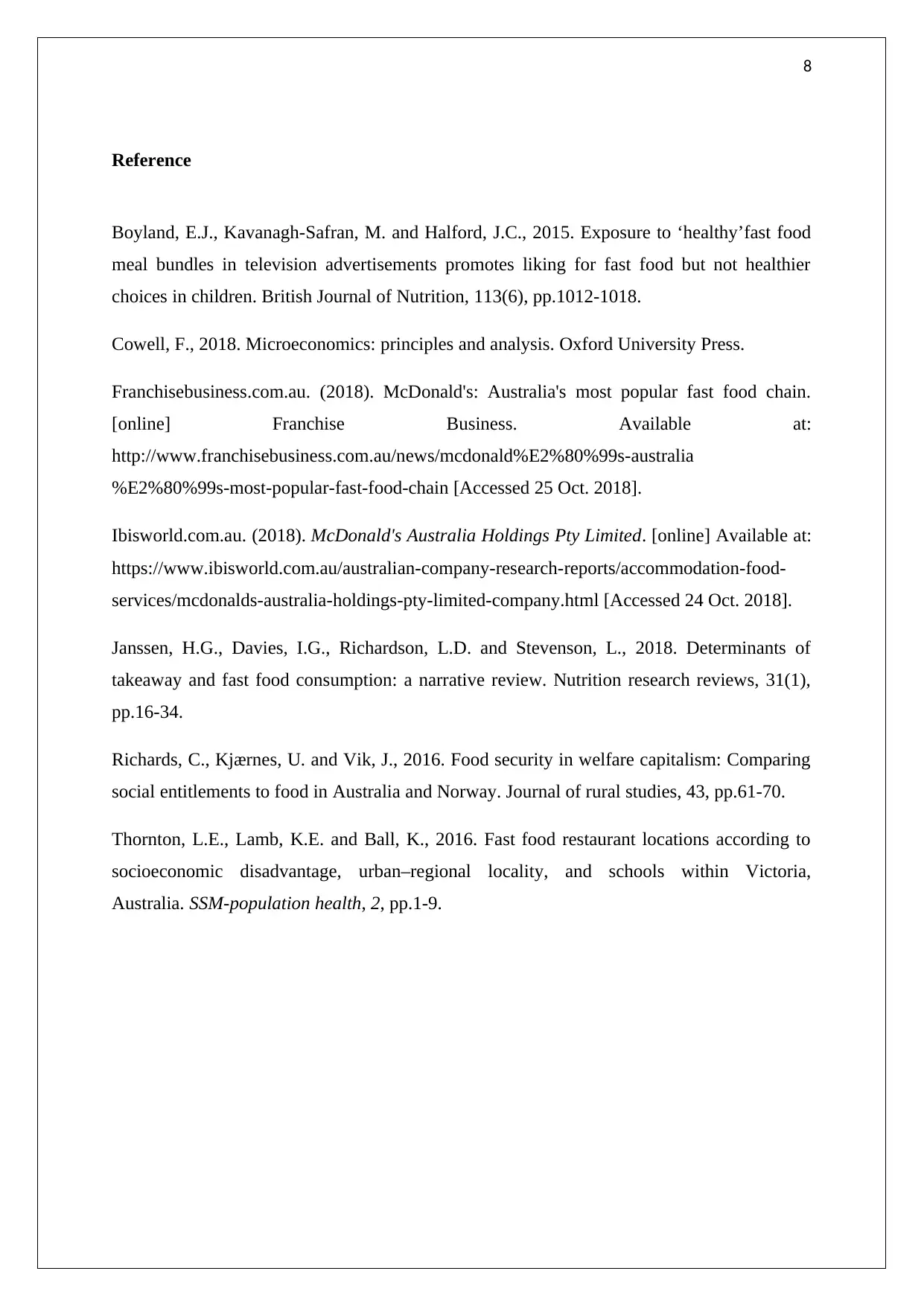
8
Reference
Boyland, E.J., Kavanagh-Safran, M. and Halford, J.C., 2015. Exposure to ‘healthy’fast food
meal bundles in television advertisements promotes liking for fast food but not healthier
choices in children. British Journal of Nutrition, 113(6), pp.1012-1018.
Cowell, F., 2018. Microeconomics: principles and analysis. Oxford University Press.
Franchisebusiness.com.au. (2018). McDonald's: Australia's most popular fast food chain.
[online] Franchise Business. Available at:
http://www.franchisebusiness.com.au/news/mcdonald%E2%80%99s-australia
%E2%80%99s-most-popular-fast-food-chain [Accessed 25 Oct. 2018].
Ibisworld.com.au. (2018). McDonald's Australia Holdings Pty Limited. [online] Available at:
https://www.ibisworld.com.au/australian-company-research-reports/accommodation-food-
services/mcdonalds-australia-holdings-pty-limited-company.html [Accessed 24 Oct. 2018].
Janssen, H.G., Davies, I.G., Richardson, L.D. and Stevenson, L., 2018. Determinants of
takeaway and fast food consumption: a narrative review. Nutrition research reviews, 31(1),
pp.16-34.
Richards, C., Kjærnes, U. and Vik, J., 2016. Food security in welfare capitalism: Comparing
social entitlements to food in Australia and Norway. Journal of rural studies, 43, pp.61-70.
Thornton, L.E., Lamb, K.E. and Ball, K., 2016. Fast food restaurant locations according to
socioeconomic disadvantage, urban–regional locality, and schools within Victoria,
Australia. SSM-population health, 2, pp.1-9.
Reference
Boyland, E.J., Kavanagh-Safran, M. and Halford, J.C., 2015. Exposure to ‘healthy’fast food
meal bundles in television advertisements promotes liking for fast food but not healthier
choices in children. British Journal of Nutrition, 113(6), pp.1012-1018.
Cowell, F., 2018. Microeconomics: principles and analysis. Oxford University Press.
Franchisebusiness.com.au. (2018). McDonald's: Australia's most popular fast food chain.
[online] Franchise Business. Available at:
http://www.franchisebusiness.com.au/news/mcdonald%E2%80%99s-australia
%E2%80%99s-most-popular-fast-food-chain [Accessed 25 Oct. 2018].
Ibisworld.com.au. (2018). McDonald's Australia Holdings Pty Limited. [online] Available at:
https://www.ibisworld.com.au/australian-company-research-reports/accommodation-food-
services/mcdonalds-australia-holdings-pty-limited-company.html [Accessed 24 Oct. 2018].
Janssen, H.G., Davies, I.G., Richardson, L.D. and Stevenson, L., 2018. Determinants of
takeaway and fast food consumption: a narrative review. Nutrition research reviews, 31(1),
pp.16-34.
Richards, C., Kjærnes, U. and Vik, J., 2016. Food security in welfare capitalism: Comparing
social entitlements to food in Australia and Norway. Journal of rural studies, 43, pp.61-70.
Thornton, L.E., Lamb, K.E. and Ball, K., 2016. Fast food restaurant locations according to
socioeconomic disadvantage, urban–regional locality, and schools within Victoria,
Australia. SSM-population health, 2, pp.1-9.
1 out of 8
Related Documents
Your All-in-One AI-Powered Toolkit for Academic Success.
+13062052269
info@desklib.com
Available 24*7 on WhatsApp / Email
![[object Object]](/_next/static/media/star-bottom.7253800d.svg)
Unlock your academic potential
Copyright © 2020–2025 A2Z Services. All Rights Reserved. Developed and managed by ZUCOL.




